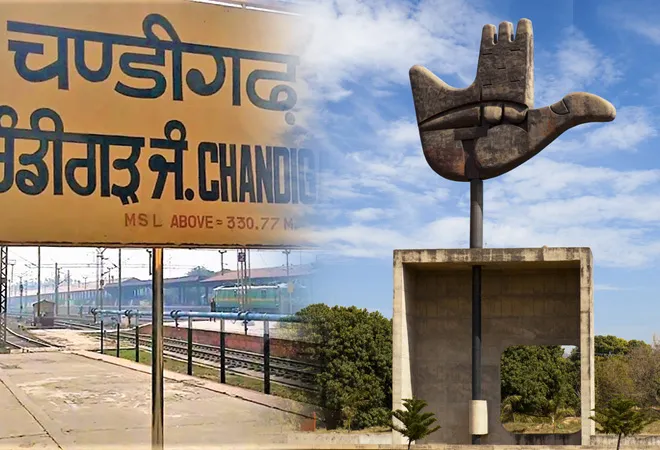
The recent decision of the Union government to notify that the Central Services Rules is to be applied to the government employees of the Union Territory (UT) of Chandigarh rather than the existing Punjab Services Rules has raked up a protracted inter-state territorial dispute. The ensuing conflict that has continued for more than five decades now, is mainly between states of Punjab and Haryana over the Union Territory of Chandigarh. In response to the recent move of the Union government, the Punjab government led by the newly elected AAP government has sharply reacted to the decision accusing the Centre of usurping Punjab’s jurisdiction over Chandigarh. The Punjab Assembly passed a resolution asserting its sole claim over the territory of Chandigarh. It strongly urged the Centre to hand over Chandigarh to Punjab. Haryana, in turn, has also passed a resolution countering Punjab’s move stating that the “Centre should not take any steps that would disturb the existing balance between the two states and maintain harmony till all the issues emanating from the reorganisation of Punjab are settled.”
The Punjab government led by the newly elected AAP government has sharply reacted to the decision accusing the Centre of usurping Punjab’s jurisdiction over Chandigarh.
Revisiting the history
The territorial dispute over Chandigarh has a long history. Due to the partition of 1947, as Lahore, the capital of undivided Punjab till the colonial period, became a part of the dominion of Pakistan, the post-partition state of Punjab in India needed a new capital city. After the independence, Prime Minister Jawaharlal Nehru in consultation with Punjab initiated a project in 1948 to build the planned city of Chandigarh at the foothills of Shivaliks that would serve as Punjab’s capital. Shimla served as Punjab’s temporary capital for some time until Punjab’s capital was officially transferred from Shimla to Chandigarh on September 21, 1953. The dispute erupted when the state of Haryana was carved out in 1966 through the Punjab Reorganisation Act of 1966. The hilly regions of undivided Punjab were also transferred to the state of Himachal Pradesh. Since 1966, Chandigarh was made a UT under the direct control of the Centre but the laws in force in undivided Punjab were made applicable to the UT. The UT of Chandigarh became the common capital of both Punjab and Haryana, and properties were divided between the two states in the ratio 60:40. At that time, the Central government declared that the new state of Haryana will eventually get a separate capital and Chandīgarh as a whole would be given back to Punjab.
The Centre came very close to transferring Chandigarh to the state of Punjab in July 1985 while Hindi-speaking towns like Abohar and Fazilka were to be given to Haryana, which was committed as part of the Rajiv–Longowal treaty but it couldn’t be implemented.
Though the Centre at that time also pondered over the idea of dividing the territory of Chandigarh into two for both the states; however, that was not structurally possible given the planning of the city. Therefore, the centre asked the state of Haryana to use Chandigarh as its capital for five years and build its own capital for which the Union government offered financial assistance to Haryana. But even after many decades, the plan of a separate capital for Haryana have not materialised till date. The Centre came very close to transferring Chandigarh to the state of Punjab in July 1985 while Hindi-speaking towns like Abohar and Fazilka were to be given to Haryana, which was committed as part of the Rajiv–Longowal treaty but it couldn’t be implemented. Militancy in Punjab in 1980s and 90s along with the lack of consensus between the two states on resolving the issue, kept the dispute alive. The Punjab leaders has continuously demanded for the transfer of whole of Chandigarh to the state of Punjab and a number of resolutions were passed in the Punjab Assembly upholding their sole jurisdiction over Chandigarh.
Conflicting claims and continuing political slugfests
Such a prolonged territorial dispute over the territory of Chandigarh involves multiple nuanced claims posited by different stakeholders of the dispute. There are primarily three factors shaping the overlapping claims in this dispute—territorial claims, resource distribution, and political expediency. First, the claim over the territory of Chandigarh is linked with the identity and sentiment of the claimant states. For Punjab, Chandigarh serves as its ‘cultural nerve centre’ and is also a major source of the state’s GDP. The leaders of Punjab have also repeatedly asserted the state’s historic claim over Chandigarh and cited number of Centre’s assurances of transferring whole of Chandigarh to Punjab. On the other hand, though Haryana has developed crucial financial centres like Faridabad and Gurugram, it claims a share over Chandigarh as it considers the UT to be an integral part of Haryana’s Ambala district. So, all the parties in both states are united in their claim over the UT as it is connected to an emotive issue of state’s territorial rights. Also, a judgement was delivered by the Supreme Court in 2011, in which the court ruled that Himachal Pradesh “was entitled to get 7.19 percent of Chandigarh’s land on the basis of the Punjab Reorganisation Act, 1966.” The Chief Minister of Himachal Pradesh, Jay Ram Thakur, has also recently raked up the demand of getting the state’s share in Chandigarh. The most crucial stakeholder in this issue is the UT of Chandigarh itself. In the light of the recent controversy, Chandigarh’s civic body passed a resolution expressing its wish to remain as an UT with a Vidhan Sabha, preserving its autonomous status under the Centre.
The leaders of Punjab have also repeatedly asserted the state’s historic claim over Chandigarh and cited number of Centre’s assurances of transferring whole of Chandigarh to Punjab.
Second, better access to resources has been a priority for all the stakeholders. One of the major causes of Punjab’s resentment has been its declining share in the Chandigarh administration and the increase in the posting of central officers in the UT. Punjab also raised concern about the distortion in the shared management of common assets like Bhakra Beas Management Board (BBMB) by the two states. Haryana, on the other hand, has been asking for a separate high court and 20 rooms in the Vidhan Sabha complex in Chandigarh which it alleges has been illegally occupied by Punjab. Himachal Pradesh, has in turn, demanded 7.19 percent share of the power being generated from the Bhakra Nangal project. The Centre has declared that the government employees of Chandigarh will benefit from the revised rules with better pay structure, higher retirement age, and better childcare leave policy. But concerns have also been raised that with Central rules in place, the UT will be deprived of existing higher age bar for government jobs and the city compensatory allowance which Punjab service rules provided. So, there has been conflicting perception on whether Centre’s or Punjab’s service rules is better for the UT’s government employees as Chandigarh which was under Central rules earlier in late 1980s demanded Punjab rules for better opportunities that was implemented in 1991.
Third, experts have opined that apart from the conflicting territorial claims and varying perceptions of interest by various stakeholders, political considerations might have also drove the recent controversy. The Chandigarh civic body which remained a BJP stronghold until recently, witnessed considerable political footprints of AAP in the last election held in December 2021. It is increasingly speculated that the Centre’s move might help BJP in Chandigarh electorally for 2024 Lok Sabha election as it will curry favour with the sections of government employees who will be benefitted by the Central service rules. On the other hand, for AAP, which sensationally captured power in Punjab and is making political inroads in Chandigarh, preserving its influence in the region is crucial for its political consolidation in both Punjab, Haryana, as well as in Chandigarh.
It is increasingly speculated that the Centre’s move might help BJP in Chandigarh electorally for 2024 Lok Sabha election as it will curry favour with the sections of government employees who will be benefitted by the Central service rules.
The imperative of federal dialogue
At a time when the Centre–State relations are fraught with discords and mistrusts, the festering dispute has the potential to foment inter-state conflict which can not only upset the federal arrangement but can also derail the much-needed coordinated shared governance in this setup. To stem the dispute from aggravating into large-scale distrust and suspicion between the neighbouring states, constant dialogue between the stakeholder states–Punjab, Haryana, and Himachal Pradesh should be initiated, with the Centre acting as the coordinating authority. The concerns of the people of Chandigarh must also be taken into consideration for an amicable and a long-term settlement of the dispute. Above all, the imperative of federal dialogue keeping the politically partisan interests behind, is the need of the hour for all political stakeholders in this dispute.
The views expressed above belong to the author(s). ORF research and analyses now available on Telegram! Click here to access our curated content — blogs, longforms and interviews.




 PREV
PREV


